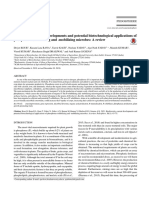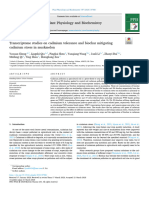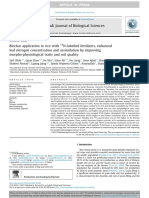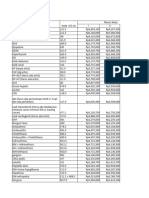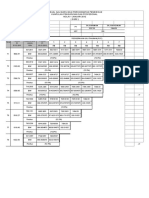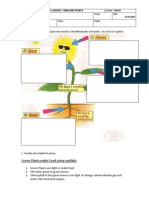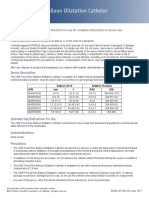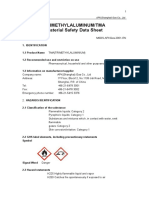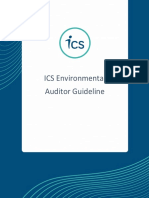Roleof Boronin Plant Growth
Roleof Boronin Plant Growth
Uploaded by
baka cijuCopyright:
Available Formats
Roleof Boronin Plant Growth
Roleof Boronin Plant Growth
Uploaded by
baka cijuOriginal Title
Copyright
Available Formats
Share this document
Did you find this document useful?
Is this content inappropriate?
Copyright:
Available Formats
Roleof Boronin Plant Growth
Roleof Boronin Plant Growth
Uploaded by
baka cijuCopyright:
Available Formats
See discussions, stats, and author profiles for this publication at: https://www.researchgate.
net/publication/235674754
Role of boron in plant growth: a review
Article in Journal of Agricultural Research · January 2009
CITATIONS READS
54 13,544
4 authors, including:
Waqar Ahmad Shamsa Kanwal
Food and Agriculture Organization of the United Nations University of Agriculture Faisalabad
36 PUBLICATIONS 475 CITATIONS 23 PUBLICATIONS 293 CITATIONS
SEE PROFILE SEE PROFILE
Some of the authors of this publication are also working on these related projects:
Investigation of rhizosphere effects on carbon dioxide emission from agricultural soils under different land uses View project
biofortification View project
All content following this page was uploaded by Waqar Ahmad on 30 May 2014.
The user has requested enhancement of the downloaded file.
Role of boron in plant growth 329
ROLE OF BORON IN PLANT GROWTH: A REVIEW
Waqar Ahmad*, A. Niaz**, S. Kanwal***, Rahmatullah***
and M. Khalid Rasheed**
ABSTRACT
Boron (B) is considered as an essential element for plant growth and
development. Sexual reproduction in plant is more sensitive to low B, than
vegetative growth. Considerable research activities have been directed at
accentuating the physiological and biochemical role of B in plant growth and
development. This paper reviews the literature (upto the year 2006) focusing on
the role of boron in cell wall integrity, cell division, plasma membranes, phenol
metabolism, and its requirement for the nitrogen fixation and in the
reproductive growth of plants.
KEYWORDS: Boron; plant growth; cell division; cell wall; Pakistan.
INTRODUCTION
Mineral nutrition of plants is important for controlling physiological and
biochemical processes of plants. Its deficiency may lead to changes in these
processes and disturbed plant growth and yield. Boron is one of mineral
nutrients that are required for normal plant growth. The essentiality of B for
growth and development of higher plants has been earlier demonstrated (27,
43, 46). The main functions of boron relate to cell wall strength and
development, cell division, fruit and seed development, sugar transport and
hormone development. Some functions of boron interrelate with those of
nitrogen, phosphorus, potassium and calcium in plant. The most important
functions of boron in plants are thought to be its structural role in cell wall
development; and stimulation or inhibition of specific metabolism pathways.
Boron and plant cell wall
*Sustainable Land Management Project, Ministry of Environment, Islamabad Email:
waqqar80@gmail.com, **Soil Chemistry Section, AARI, Faisalabad, ***Plant Nutrition
Lab., Institute of Soil and Environmental Sciences, University of Agriculture, Faisalabad,
Pakistan.
J. Agric. Res., 2009, 47(3)
330 W. Ahmad et al.
Plant cell wall is composed of three main layers i.e. primary wall, secondary
wall and middle lamella. Primary wall is set down by cells before and during
active growth and comprises pectic polysaccharides (Ca. 30%), cross-linking
glycans-hemicellulose (Ca. 25%), cellulose (15-30%) and protein (Ca. 20%)
(13). Secondary wall in some cells deposits additional layers inside the
primary wall. This occurs after growth stops or when the cell begins to
differentiate. The secondary wall is mainly for support and comprises
primarily cellulose and lignin. Middle lamella that binds adjacent cells is
composed of pectic polysaccharides. The actual content of wall components
varies with species and age. Some researchers estimate that over 90
++
percent of total B is localized in cell walls (26, 29). Boron along with Ca is
able to form complexes with several cell wall components such as pectins
(21), polyhydroxyl polymers, polyols and Ca++ (31, 44). This is the reason that
B is implicated in synthesis and stability of cell wall (16) by forming esters
with cis diol groups present in cell wall (26). This provides rigidity, strength
and shape to the cell.
Cell division
Boron is considered to be essential for actively growing regions of plants,
such as root tips, new leaf and bud development. According to Rerkasem
(37) boron is especially required more in meristematic cells than in mature
tissues. That is why; first effect of boron deficiency usually appears in
meristems, as described by Warington (46). Higher meristematic B
requirement may rise because of low phloem transport from shoots to other
parts of plant, leading to higher accumulation of B in leaves (37).
Ion fluxes
Boron plays an important role in both structural and functional integrity of
plasma membranes (28, 31). In B-deficient plants, plasma membranes are
highly leaky and lose their functional integrity (11). In many instances, it is
+ + + -3 +2
proved that fleet alterations in ion fluxes i.e. H , K , Rb , PO4 , and Ca is
associated with B deficiency (38, 39).
The proton efflux by membrane-bound ATPases is a main driving force for
ion uptake and responsible for a gradient in electrical potential across the
membranes (36, 41). The stimulated activity of plasma membrane NADH
+
oxidase and H secretion in cultured carrot cells with boron has also been
reported by Barr and Crane (3). Apparently, auxin affects B-induced H+
extrusion. According to Hu and Brown (20) the stimulatory effect of B on H+-
J. Agric. Res., 2009, 47(3)
Role of boron in plant growth 331
ATPase activity requires the presence of auxin, or enhancement in proton
release by auxin requires the presence of B. In the studies with sunflower
root cells and dense leaved elodea (Elodea densa) leaf cells, a significant
depolarisation of membranes was found after transfer of cells from B-
containing to B-free solution. Hence, boron nutrition has marked effects on
proton secretion and creation of an electrical potential gradient across the
membranes (5).
Boron supply enhances the activity of membrane bound ATPase and
subsequently causes hyperpolarization of plasma membrane by stimulating
+
K ion uptake The pumping activity of the membranes with subsequent
membrane hyperpolarization, results in an increased driving force for K+
influx (42). As far as K+ is concerned, it is involved in the opening and closing
+
of stomata. By affecting K influx, B was also found involving in enhancement
of stomatal opening in epidermal strips of dayflower (Commelina communis)
+
(41). A number of researchers have observed the excessive leakage of K
with B deficiency that leads to a decrease in membrane integrity. Some
researchers consider this effect of B as a primary effect while others attribute
it to secondary effect of boron deficiency.
Uptake rate of phosphate is decreased by B deficiency and is rapidly restored
by resupply of B to deficient plants for one hour (40). More rapid effects of B
on ion influx or efflux were shown by Poole (32) in Zea mays (maize). He
found that resupply of B to deficient maize for one hour caused a significant
restoration of phosphate uptake (Table 1).
The data (Table 1) show the variation in phosphorus uptake (nmol/g/h) in
faba bean and maize under the pretreatment of root tips with B for one hour
and without pretreatment (no B) of root tips. The data markedly indicate that
pretreatment of root tips increased the uptake of inorganic phosphorus both
in faba bean and maize as compared to without pretreatment.
Table 1. Effect of treatment on subsequent uptake of inorganic phosphate
by root tip zones of faba bean (Vicia faba) and maize (Zea mays)
grown in (+ B) or (- B)
Pretreatment of root tips Phosphate uptake (nmol/g/h)
Faba bean Maize
+B -B +B -B
No boron 112 52 116 66
-5
10 M B 152 108 190 171
Source: Poole (32)
J. Agric. Res., 2009, 47(3)
332 W. Ahmad et al.
Phenol metabolism
Phenol metabolism also plays a very important role in plant growth which
seems to be affected by B nutrition. Kamali and Childers (24) studied the
effects of B deficiency on several phenolics and enzyme activities involved in
the biosynthesis of these compounds in tobacco plant. In B-deficient plants a
higher amount of phenolic compounds is accumulated (10). This higher
amount of phenolic is very hazardous for plants. With increase in the amount
of phenolic compounds, enzymatic or non-enzymatic oxidation takes place, in
which phenolic compounds act as substrate. Thus, toxic quinones and
destructive O2 species are generated (1, 23). The phenolics after oxidation
corroborate changes in ion fluxes accompanied by changes in membrane
potential (19). It has been suggested that phenolics result in reversible
alterations in membrane permeability, and this effect of phenolics occurs
during their passage through the membranes (18, 19).
In B-deficient plants, not only the phenolic compounds increase but also
defence capacity of cells against toxic O2 species is weakened due to
reduced levels of ascorbic acid, SH-compounds and H2O2 scavenging
enzymes (9). So, it can be suggested that B deficiency renders membrane
leakiness and alteration in ion flux characterized by peroxidative damage and
structural alteration in plasma membranes.
Boron and nitrogen fixation
Boron is also involved in nitrogen fixation. Loomis and Durst (26) reported
that boron is an essential micronutrient required for growth and development
of vascular plants, diatoms and species of marine algal flagellates, while
bacteria, fungi, green algae and animals apparently do not require B. Not
only the leguminous plants but also cyanobacteria require B when dependent
on N2 fixation. Under B-deficient conditions, nodule weight and N2 fixation
capacity of legumes is usually decreased. Bolanos et al. (6) investigated the
effect of boron on symbiotic nitrogen fixation in pea (Pisum sativum). The
absence of boron in culture medium resulted in lower number of nodules and
alterations in nodule development. Nodules were not only found less in
number but also nodule structure was disorganized and not easily
distinguishable in B deficient media. Examination of boron deficient nodules
showed dramatic changes in cell wall and in both peribacteriod and infection
thread membranes, suggesting a role of boron in the stability of these
structures (7). The formations of ineffective nodules have also been reported
earlier (8, 42). This alteration of nodule development led to an inhibition of
J. Agric. Res., 2009, 47(3)
Role of boron in plant growth 333
nitrogenase activity. These results indicated that boron is a requirement for
normal nodule development and functionality.
Boron and plant reproductive growth
It has been reported that boron deficiency limits reproductive growth. In
wheat, B deficiency causes poor anther and pollen development, low grain
set and stunted growth (12, 33). In vitro germination tests also showed that B
was required for pollen germination and tube growth in wheat (12). Seed
setting is important for improving yield from any soil particularly salt affected
soils. Aslam et al. (2) reported better pollination, seed setting, low spike
sterility and more grain formation in different cultivars of rice as an effect of
boron nutrition. Rashid et al. (33) observed a substantial increase in grain
yield of rice cultivars, due to reduced panicle sterility after B application. Jiang
and Miles (22) identified critical stages of anther development of wheat
during which B deficiency caused a significant and irreversible decrease of
floret fertility. According to Cakmak (9), B has limited phloem mobility in
crops like wheat. Hence, B supply is required for healthy reproductive growth
(anther, pollen and ovule development). Loomis and Durst (25) reported the
abortion of apical meristems leading to the lack of flowering and development
in peach (Prunus persica) in boron free medium. Some physiologists (4, 35,
36, 47) have observed the effect of boron nutrition on flowering, stamens,
pistil and young reproductive leaves (Table 2 and 3). Generally, the
concentration of boron in flower, stamen, and pistil is increased with increase
in boron supply from low to adequate level. This is the indicator of response
of young reproductive plant parts and leaves to supply of boron.
Table 2. Boron concentration (mg/g dry weight) in young reproductive parts and
leaves in oilseed rape (Brassica napus), wheat (Triticum aestivum) and green
gram (Vigna radiata) in relation to B supply.
Crops B supply Flower Stamen Pistil Leaf
1
Oilseed rape Low - 19 19 10
Adequate - 38 40 17
2 3
Green gram Low 30 - 19 11
Adequate 61 - - 34
4 5
Wheat Adequate - 16 8 3
1 2
Adapted from Dell B. L. Huang (14), Pot study in soil by Zhang et al. (47) Pot
study in solution culture by Bell et al. (4). The data for the low boron plants is
3 4
after transfer to solution without B for 4 days. Data for young pods. Field
5
study by Rerkasem (37). Data for anthers.
J. Agric. Res., 2009, 47(3)
334 W. Ahmad et al.
Table 3. Mean B concentration (mg/kg) in young whole leaves as affected by B
application to a B-deficient media in wheat (Triticum aestivum L.) and rice
(Oryza sativa L.) cultivars.
B concentration (mg/kg) in leaves
Wheat cultivars Control +B Rice cultivars Control +B
Rohtas-90 5.2 11.0 Super Basmati 7.58 11.24
Sindh-81 9.0 17.0 Basmati-6129 9.36 16.19
Faisalabad-85 8.0 10.3 DR-83 9.07 14.70
Rawal-87 9.3 18.0 KS-282 9.86 16.67
Pak-81 8.7 15.8 Basmati-385 7.14 8.42
Sariab-92 10.0 19.5 Pakhal 9.29 11.56
Inqalab-91 7.2 20.7 Basmati-370 7.43 9.79
Bakhtawar 11.0 21.0 IR-6 8.62 11.31
Adapted from Rashid et al. (35)
SUMMARY
Above review indicates that boron performs many functions in cell walls (30)
and cellular activities (11). Boron deficiency renders decrease in cell wall
plasticity (21) leading to failure of newly divided cells to enlarge (15). As far
as plasma membrane is concerned, adequate level of boron stops the
accumulation of phenolics and ceases the oxidation of components of
+
plasma membranes. Further it is also involved in the generation of H
ATPase, which is a driving force for ion uptake. Hence, integrity and
functionality of plasma membranes is ensured with adequate supply of boron.
The nitrogen fixation ultimately correlates with nitrogenase activity. Oxygen
sensitivity of nitrogenase is well known and relates to toxicity of O2 species
such as O2- and H2O2 (13). Therefore, activity of O2- and H2O2 scavenging
enzymes may play an essential role in protecting nitrogenase against toxic O2
species. Since nitrogenase activity is dependent on the development of
effective nodules, any alteration in nodule development inhibits the
nitrogenase activity. Boron accelerates nitrogenase activity through effective
nodule development for nitrogen fixation. Plants reproductive growth is
ceased with the deficiency of boron. This retarding growth is considered due
to the low phloem mobility of boron. In brief, the formation of B complexes
with the constituents of cell wall and plasma membrane as well as with the
phenolic compounds is a major reason to affect the physiological functions of
boron.
Pollard et al. (31) reported several impairments as a result of B deficiency,
such as sugar transport, cell wall synthesis, signification, cell wall structure,
carbohydrate metabolism, RNA metabolism; respiration, indole acetic acid
(IAA) metabolism, phenol metabolism, and membrane integrity.
J. Agric. Res., 2009, 47(3)
Role of boron in plant growth 335
The above discussion reveals unique physiological role played by boron in
plants. However, despite such numerous effects of B, no evidence has yet
been presented that B is an enzyme constituent or it has a direct role in
enzyme activities. It is also not clear whether above mentioned changes are
precursor of direct functions of B or the changes are of an indirect nature.
Therefore, a lot of research activities are required to have an insight whether
role played by boron nutrition is primary or secondary.
REFERENCES
1. Appel, H.M. 1993. Phenolics in ecological interaction: the importance
of oxidation. J. Chem. Ecol. 19: 1521–1552.
2. Aslam, M.I., H. Mahmood, R.H. Qureshi, S. Nawaz and J. Akhtar.
2002. Salinity tolerance of rice as affected by boron nutrition. Pak. J.
Soil Sci. 21: 110-118.
3. Barr, R., M. Bottger and F.L. Crane. 1993. The effect of B on plasma
membrane electron transport and associated proton secretion by
cultured carrot cells. Biochem. Mol. Biol. Int. 31, 31-39.
4. Bell, R.W., L. McLay, D. Plaskett, B. Dell and J.F. Loneragan. 1990.
Internal boron requirements of green gram (Vigna radiata). In: Plant
Nutri. Physiol. Appli. M.L van Beusichem (ed.). Kluwer Academic
Publishers, Dordrecht, the Netherlands. p. 275-280.
5. Blaser-Grill, J., D. Knoppik, A. Amberger and H. Goldbach. 1989.
Influence of boron on the membrane potential in Elodea densa and
Helianthus annus roots and H+ extrusion of suspension cultured
Daucus carota cells. J. Pl. Physiol. 90: 280–284.
6. Bolanos, L., E. Esteban, C. De Lorenzo, M. Fernandez-Pascual, M.R.
De Felipe, A. Garate and I. Bonilla. 1994. Essentiality of boron for
symbiotic dinitrogen fixation in pea (Pisum sativum) rhizobium
nodules. Pl. Physiol. 104: 85–90.
7. Brenchley, W.E., and H.G. Thornton. 1925. The relation between the
development, structure and functioning of the nodules on Vicia juba,
as influenced by the presence or absence of boron in the nutrient
medium. Proc R SOC Lond. Biol. Sci. 498: 373-398.
8. Brown, P.H., and B.J. Shelp. 1997. Boron mobility in plants. Pl. Soil.
193:85-102.
9. Cakmak, I. 1994. Activity of ascorbate-dependent H2O2-scavenging
enzymes and leaf chlorosis are enhanced in magnesium- and
potassium-deficient leaves, but not in phosphorus-deficient leaves. J.
Exp. Bot. 45:1259–1266.
J. Agric. Res., 2009, 47(3)
336 W. Ahmad et al.
10. Cakmak, I. and V. Romheld. 1997. Boron deficiency induced
impairments of cellular functions in plants. Pl. Soil. 193:71-84
11. Cheng, C. and B. Rerkasem. 1993. Effects of boron on pollen viability
in wheat. Pl. Soil. 155/156:313-315.
12. Dalton, D. A, S. A. Russell, F. J. Hanus, G. A. Pascoe and H .J.
Evans. 1986. Enzymatic reactions of ascorbate and glutathione that
prevent peroxide damage in soybean root nodules. Proc. Nat. Acad.
Sci. USA .83:3811–3815.
13. Darvil, A., M. McNeil, M. P. Albersheim and D. P. Delmer. 1980. The
primary cell wall of flowering plants. In: The Biochemistry of Plants. A
comprehensive treatise. Tolbert, N.E (ed.). Pp. 91-161. Academic
Press, New York.
14. Dell, B., L. Huang. 1997. Physiological response of plants to low
boron. Pl. Soil. 193: 103-120.
15. Fleischer, A., C. Titel and R. Ehwald. 1998. The boron requirement
and cell wall properties of growing and stationary suspension-cultured
Chenopodium album L. cells. J. Pl. Physiol. 117:1401-1410.
16. Glass, A.D.M. 1973. Influence of phenolic acids on ion uptake. I.
Inhibition of phosphorus uptake. Pl. Physiol. 51: 1037–1041.
17. Glass, A.D.M. 1974. Influence of phenolic acids upon ion uptake. III.
Inhibition of potassium absorption. J. Exp. Bot. 25: 1104–1113.
18. Glass, A.D and M. Dunlop. 1974. Influence of phenolic acids on ion
uptake. IV. Depolarisation of membrane potentials. Pl. Physiol.54:
855–858.
19. Goldbach, H.E., D. Hartmann and T. Rotzer. 1990. Boron is required
for the ferricyanide-induced proton release by auxins in suspension
cultured cells of Daucus carota and Lycopersicon esculentum.
Physiol. Pl. 80:114–118.
20. Hu, H. and P.H. Brown. 1994. Localisation of boron in the cell wall
and its association with pectin. Evidence of a structural role of boron
in the cell wall. Pl. Physiol. 105:681–689.
21. Huang, L., J. Pant, B. Dell and R. Bell. 2000. Effects of boron
deficiency on anther development and floret sterility in wheat (Triticum
aestivum L. ‘Wilgoyne’). Ann. Bot. 85:493-500.
22. Jiang, Y and P.W. Miles. 1993. Generation of H2O2 during enzymic
oxidation of catechin. Phytochem. 33: 29–34.
23. Juan, J., Camacho-Cristóbal, D. Anzellotti and A. González-Fontes.
2002. Changes in phenolic metabolism of tobacco plants during short-
term boron deficiency. J. Pl. Physiol. Biochem. 40:997-1002.
J. Agric. Res., 2009, 47(3)
Role of boron in plant growth 337
24. Kamali, A. R. and N. F. Childers. 1970. Growth and fruiting of peach
in sand culture as affected by boron and fritted form of trace
elements. J. Amer. Soc. Hort. Sci. 95:652-656.
25. Loomis, W.D. and R.W. Durst. 1991. Boron and cell walls. Curr.
Topics Pl. Biochem. Physiol. 10:149–178.
26. Loomis, W.D and R.W. Durst. 1992. Chemistry and biology of boron.
Bio Factors. 4:229–239.
27. Marschner, H. 1995. Mineral Nutrition of Higher Plants. p. 379 - 396.
Academic Press, San Diego, USA.
28. Martin, F. and M. Theiller. 1993. Boron distribution in parenchyma
cells of clover leaves. Pl. Physiol. Biochem. 31:777-786.
29. Matoh, T., S. Kawaguchi and M. Kobayashi. 1996. Ubiquity of a
borate-rhamnoglacturonan II complex in the cell walls of higher plants.
Pl. Cell Physiol. 37:636-640.
30. Parr, A.J. and B.C. Loughman. 1983. Boron and membrane function
in plants. In: Metals and Micronutrients, Uptake and Utilisation by
Plants. Robb, D.A and W.S. Pierpoint (eds.). Academic Press, New
York. p. 87–107.
31. Pollard, A.S., A.J. Parr and B.C. Loughman. 1977. Boron in relation to
membrane function in higher plants. J. Exp. Bot. 28:831–841.
32. Poole, R.J. 1978. Energy coupling for membrane transport. Ann. Rev.
Pl. Physiol. 29:437-460.
33. Rashid, A., E. Rafique and N. Bughio. 1994. Diagnosing boron
deficiency in rapeseed and mustard by plant analysis and soil testing.
Communications in Soil Science and Plant Analysis. 25(17/18):2883-
2897.
34. Rashid, A., M. Yasin, M. Ashraf and R.A. Mann. 2004. Boron
deficiency in calcareous soil reduces rice yield and impairs grain
quality. International Rice Research Notes. 29: 58-60.
35. Rashid, A., S. Muhammad and E. Rafique. 2005. Rice and wheat
genotypic variation in boron use efficiency. Soil Environ. 24:98-102.
36. Raven, J.A. 1980. Short and long distance transport of boric acid in
plants. New Phytol. 84: 231-249.
37. Rerkasem, B. 1996. Boron and plant reproductive development. In:
Sterility in Wheat in Sub-tropical Asia: Extent, Causes and Solutions.
Rawson, H .M. and K. D. Subedi (eds.). p. 32-35. ACIAR Proc. No.
72.
38. Robertson, G.A. and B.C. Loughman. 1973. Rubidium uptake and
boron deficiency in Vicia faba. J. Exp. Bot. 24:1046–1052.
J. Agric. Res., 2009, 47(3)
338 W. Ahmad et al.
39. Robertson, G.A., and B.C. Loughman. 1974. Reversible effects of
boron on the absorption and incorporation of phosphate in Vicia faba.
New Phytol. 73:291–298.
40. Roth-Bejerano, N. and C. Itai. 1981. Effect of boron on stomatal
opening in epidermis strips of Commelina communis. Physiol. Pl.
52:302–304.
41. Schon, M.K, A. Novacky and D.G. Blevins. 1990. Boron induces
hyperpolarisation of sunflower root cell membranes and increases
membrane permeability to K+. J. Pl. Physiol. 93:566–577.
42. Serrano, R. 1989. Structure and function of plasma membrane
ATPase. Ann. Rev. Pl. Physiol. 40:61–94.
43. Shelp, B.J. 1993. Physiology and biochemistry of boron in plants. In:
Boron and its Role in Crop Protection. Gupta, U. C. (ed.). p. 53–85.
CRC Press, Boca Raton, FL, USA.
44. Sommer, A.L. and H. Sorokin. 1928. Effects of the absence of boron
and of some other essential elements on the cell and tissue structure
of the root tips of Pisum sativum. Pl. Physiol.3: 237-260.
45. Trefil, J.S. 2001. Encyclopedia of Science and Technology; Taylor
and Francis Group, New York.
46. Warington, K. 1923. The effect of boric acid and borax on the broad
bean and certain other plants. Ann. Bot. 37:629–672.
47. Zhang, X., Z. Shen and K. Shen. 1994. The effect of boron on the
development of floral organs and seed yield of rape (In Chinese).
Acta Pedologica Sinica. 31:146-151.
J. Agric. Res., 2009, 47(3)
View publication stats
You might also like
- GLPH 385 Final Exam NotesDocument118 pagesGLPH 385 Final Exam Notescameronwallace.10No ratings yet
- Virtues, Vices and Values - The Master List - 2020Document40 pagesVirtues, Vices and Values - The Master List - 2020Andrea Lourdes Di Leo100% (1)
- Boron: Functions and Approaches To Enhance Its Availability in Plants For Sustainable AgricultureDocument20 pagesBoron: Functions and Approaches To Enhance Its Availability in Plants For Sustainable AgricultureQasim aliNo ratings yet
- Boron Chapter Complete (04.09.2023)Document23 pagesBoron Chapter Complete (04.09.2023)Prakriti VyasNo ratings yet
- Impact of Boron Deficiency On Plant Growth: January 2013Document4 pagesImpact of Boron Deficiency On Plant Growth: January 2013endang saptiningsihNo ratings yet
- Synopsis PuruDocument15 pagesSynopsis PuruAmit KumarNo ratings yet
- Absorption of Boron by Plant RootsDocument11 pagesAbsorption of Boron by Plant RootsKenia SantosNo ratings yet
- Energies 16 00410 v2Document32 pagesEnergies 16 00410 v2Zainab JavedNo ratings yet
- Sun2020 Article PlantGrowth-PromotingEffectOfTDocument13 pagesSun2020 Article PlantGrowth-PromotingEffectOfTJADSONNo ratings yet
- Role of Some of Mineral Nutrients in Biological Nitrogen Fixation Bulletin of PDFDocument9 pagesRole of Some of Mineral Nutrients in Biological Nitrogen Fixation Bulletin of PDFitsasweetlife sosweetNo ratings yet
- Study On The Mechanism of Biochar Affecting The Effectiveness of Phosphate Solubilizing BacteriaDocument12 pagesStudy On The Mechanism of Biochar Affecting The Effectiveness of Phosphate Solubilizing BacteriaNisrinaNo ratings yet
- Effect of Bio-Fertilizer in Soybean CultivationDocument9 pagesEffect of Bio-Fertilizer in Soybean CultivationrealzobaerNo ratings yet
- Biodiversity, Current Developments and Potential Biotechnological Applications of Phosphorus-Solubilizing and - Mobilizing Microbes: A ReviewDocument33 pagesBiodiversity, Current Developments and Potential Biotechnological Applications of Phosphorus-Solubilizing and - Mobilizing Microbes: A ReviewedyNo ratings yet
- Benefits of PSBDocument21 pagesBenefits of PSBoussa attasNo ratings yet
- Ajps 2020022016501459Document12 pagesAjps 2020022016501459kom dehNo ratings yet
- Bacterial Community Response in Ginseng Rhizosphere Soil - 2024 - EnvironmentalDocument13 pagesBacterial Community Response in Ginseng Rhizosphere Soil - 2024 - EnvironmentalronaldwquezadaNo ratings yet
- Artigo para SeminariosDocument10 pagesArtigo para SeminariosLorraine Da Silva SantosNo ratings yet
- Fpls 14 1094157Document15 pagesFpls 14 1094157sudhir kumarNo ratings yet
- s41598-022-11170-3Document14 pagess41598-022-11170-3ahmad.ahangar2019No ratings yet
- s41598-022-11170-3Document14 pagess41598-022-11170-3ahmad.ahangar2019No ratings yet
- Application of Micronutrients in The Rice-Wheat Cropping Systems of South Asia: A ReviewDocument17 pagesApplication of Micronutrients in The Rice-Wheat Cropping Systems of South Asia: A ReviewAnuragNo ratings yet
- Shivanietal 2019BMCMBDocument18 pagesShivanietal 2019BMCMBRaja KumarNo ratings yet
- Phosphate Solubilizing Bacteria and Their Role in Plant Growth PromotionDocument21 pagesPhosphate Solubilizing Bacteria and Their Role in Plant Growth PromotionObinna OjeNo ratings yet
- Sustainability 13 05037Document12 pagesSustainability 13 05037rehman soomroNo ratings yet
- Nutrients 16 01856Document16 pagesNutrients 16 01856jordiNo ratings yet
- agriculture-12-01706Document16 pagesagriculture-12-01706Saurav MarahattaNo ratings yet
- Pjar BoronDocument6 pagesPjar BoronSami UllahNo ratings yet
- Jurnal PPT 2Document12 pagesJurnal PPT 2wahyu arNo ratings yet
- 1 s2.0 S0048969724006594 MainDocument14 pages1 s2.0 S0048969724006594 MainTesa SembiringNo ratings yet
- Functions of Nitrogen, Phosphorus and Potassium in Energy Status and Their in Uences On Rice Growth and DevelopmentDocument14 pagesFunctions of Nitrogen, Phosphorus and Potassium in Energy Status and Their in Uences On Rice Growth and Developmentqureshisaleh63No ratings yet
- B Toxicity Causes Multiple Effects On Pollen Tube GrowthDocument12 pagesB Toxicity Causes Multiple Effects On Pollen Tube GrowthmiguelsuarezvallesNo ratings yet
- Extract Pages From EROB2Document2 pagesExtract Pages From EROB2shardul parabNo ratings yet
- 42Document21 pages42Nayo PalomequeNo ratings yet
- Articulo de Anzima - GGGDocument15 pagesArticulo de Anzima - GGGRossyNo ratings yet
- IJSARTV4I220795Document4 pagesIJSARTV4I220795Fawziyyah AgboolaNo ratings yet
- Current Trends in Plant Vitamin Biosynthesis 2329 9029.1000e109Document1 pageCurrent Trends in Plant Vitamin Biosynthesis 2329 9029.1000e109majope1966No ratings yet
- Phosphorus Supply To Plants of Vaccinium L Genus PDocument10 pagesPhosphorus Supply To Plants of Vaccinium L Genus PRaluca-Cristina GuriencuNo ratings yet
- Biochar-Based Slow-Release of Fertilizers For SustDocument19 pagesBiochar-Based Slow-Release of Fertilizers For SustirfanNo ratings yet
- Agronomy 13 00744Document12 pagesAgronomy 13 00744Diana EscobedoNo ratings yet
- Effects of Ascorbic Citric and Humic Acids On MaizDocument14 pagesEffects of Ascorbic Citric and Humic Acids On MaizAtmaNo ratings yet
- Mehran Cooton BDocument12 pagesMehran Cooton BMuhammad AshrafNo ratings yet
- Smoke 3Document18 pagesSmoke 3Rafi UllahNo ratings yet
- Plant Growth Promoting Bacillus SP Cahoots Moisture Stress 2020 MicrobioloDocument12 pagesPlant Growth Promoting Bacillus SP Cahoots Moisture Stress 2020 Microbiolomasumbuko weswaNo ratings yet
- The Effect of Rhizobia Inoculum and Mineral FertilizersDocument8 pagesThe Effect of Rhizobia Inoculum and Mineral Fertilizersclaudinasabonete5No ratings yet
- Docu 18Document24 pagesDocu 18Franco Cerna CuevaNo ratings yet
- B1 BiocharCombinedwithGarbageEnzymeEnhancesNitrogenDocument16 pagesB1 BiocharCombinedwithGarbageEnzymeEnhancesNitrogenTrupti ThakurNo ratings yet
- Nutrients and Their Importance in Agriculture Crop Production A ReviewDocument7 pagesNutrients and Their Importance in Agriculture Crop Production A ReviewmuhammadrifqirafarosyadiNo ratings yet
- Article 4Document9 pagesArticle 4Abida OtmanNo ratings yet
- 1588751474broccoli A Potentialfunctional FoodDocument4 pages1588751474broccoli A Potentialfunctional FoodMargarida FerreiraNo ratings yet
- Author's Accepted Manuscript: Biocatalysis and Agricultural BiotechnologyDocument32 pagesAuthor's Accepted Manuscript: Biocatalysis and Agricultural BiotechnologyPushpendra ChauhanNo ratings yet
- Ency AgfoodsystemsprintedchapterDocument21 pagesEncy AgfoodsystemsprintedchapterMario Javier Ganoza MoralesNo ratings yet
- Major Functions of Boron in PlantsDocument3 pagesMajor Functions of Boron in PlantsQasim aliNo ratings yet
- Chapter 11Document36 pagesChapter 11TATHAGATA RAY CHAUDHURINo ratings yet
- Beneficial Bacteria Activate Nutrients and Promote Wheat Growth Under Conditions of Reduced Fertilizer ApplicationDocument12 pagesBeneficial Bacteria Activate Nutrients and Promote Wheat Growth Under Conditions of Reduced Fertilizer ApplicationNayo PalomequeNo ratings yet
- Synergetic Effect of Microbially Fermented Soybean and NPK Fertilizer On Plant Growth of Grand Naine BananaDocument6 pagesSynergetic Effect of Microbially Fermented Soybean and NPK Fertilizer On Plant Growth of Grand Naine BananaTricia Kaye BongabongNo ratings yet
- Cadmio 3Document11 pagesCadmio 3greco lavayenNo ratings yet
- Jing (2024) Role of Calcium Nutrition in Plant Physiology Advances in Research and Insights IntoDocument15 pagesJing (2024) Role of Calcium Nutrition in Plant Physiology Advances in Research and Insights IntoGreice LealNo ratings yet
- Plant Growth Promoting RhizobiaDocument23 pagesPlant Growth Promoting RhizobiadanyjorgeNo ratings yet
- Combined Application of Bio-Organic PhosphateDocument10 pagesCombined Application of Bio-Organic PhosphateGaby IklprNo ratings yet
- Biochar 3Document15 pagesBiochar 3Jaini FakhrudinNo ratings yet
- Annual Plant Reviews, Plant Systems BiologyFrom EverandAnnual Plant Reviews, Plant Systems BiologyGloria CoruzziNo ratings yet
- Annual Plant Reviews, Phosphorus Metabolism in PlantsFrom EverandAnnual Plant Reviews, Phosphorus Metabolism in PlantsWilliam PlaxtonNo ratings yet
- (WWW - Asianovel.com) - Heavy Sweetness Ash-Like Frost Chapter Epilogue Part 1 - Chapter Epilogue Part 4Document29 pages(WWW - Asianovel.com) - Heavy Sweetness Ash-Like Frost Chapter Epilogue Part 1 - Chapter Epilogue Part 4Baekhyunnee100% (2)
- CLTD PDFDocument4 pagesCLTD PDFreis.eliel2011No ratings yet
- API Steel Check Valve API Steel Check ValveDocument3 pagesAPI Steel Check Valve API Steel Check ValveElias SusantoNo ratings yet
- Influence of Transformer Tap-Changer Control Mode Upon HVDC Valve Power LossDocument4 pagesInfluence of Transformer Tap-Changer Control Mode Upon HVDC Valve Power LossChristos ApostolopoulosNo ratings yet
- Lesson 6 Slides - The Rankine Power Cycle PDFDocument18 pagesLesson 6 Slides - The Rankine Power Cycle PDFPheza AndrewNo ratings yet
- Documentary Requirements For Common Government Transactions As Per COA Circular NoDocument1 pageDocumentary Requirements For Common Government Transactions As Per COA Circular NoJoji Marie PalecNo ratings yet
- Kamus Plavon (Diagnosis Tunggal)Document17 pagesKamus Plavon (Diagnosis Tunggal)ayu novyaningtiasNo ratings yet
- Jadual KENAIKAN GAJI 2012 01012012xlsDocument87 pagesJadual KENAIKAN GAJI 2012 01012012xlsدايڠ ازرينNo ratings yet
- Running Head: Character Analysis of Camille Preaker of Sharp Objects 1Document14 pagesRunning Head: Character Analysis of Camille Preaker of Sharp Objects 1api-478068623No ratings yet
- Denture Base MaterialsDocument65 pagesDenture Base MaterialsGitanjali Sharma33% (3)
- Olefin Metathesis: Robert H. GrubbsDocument24 pagesOlefin Metathesis: Robert H. GrubbsTiago Breve da SilvaNo ratings yet
- Exercises On PlantsDocument4 pagesExercises On PlantsbarbaregidorfjNo ratings yet
- CRE Fixed Wire Balloon Dilatation CatheterDocument2 pagesCRE Fixed Wire Balloon Dilatation CathetermaassingerNo ratings yet
- Trimethylaluminum/Tma Material Safety Data Sheet: APK (Shanghai) Gas Co., LTDDocument9 pagesTrimethylaluminum/Tma Material Safety Data Sheet: APK (Shanghai) Gas Co., LTDBerkin DereliNo ratings yet
- Cecilia - Creative Career OptionsDocument3 pagesCecilia - Creative Career OptionsEdgardo de DiosNo ratings yet
- Free Fusion Reiki Attunement Leaflet: Who Is Rev Jason Storm?Document5 pagesFree Fusion Reiki Attunement Leaflet: Who Is Rev Jason Storm?Leandro Arce100% (1)
- Diesel Engine Tune-UpDocument58 pagesDiesel Engine Tune-Upace ebradoNo ratings yet
- FinalpaperDocument21 pagesFinalpaperapi-547582127No ratings yet
- Psychological Incapacity AssignDocument2 pagesPsychological Incapacity AssignRebecca ChanNo ratings yet
- Healthcare IndustryDocument8 pagesHealthcare Industryhinal_04922350% (2)
- 2018.08.03-ICS - Environmental Auditor GuidelineDocument114 pages2018.08.03-ICS - Environmental Auditor GuidelineXavier BaudequinNo ratings yet
- SCHEDULECIVILR1Document86 pagesSCHEDULECIVILR1kathiravanNo ratings yet
- Jainson CatalogueDocument18 pagesJainson CatalogueSeanNo ratings yet
- Framework For Testing Performance For Hand Dishwashing Detergents Version 22.06.2016Document3 pagesFramework For Testing Performance For Hand Dishwashing Detergents Version 22.06.2016Shaun RimosNo ratings yet
- 3drystar 5301Document134 pages3drystar 5301Mouh ben mouNo ratings yet
- Velix en WebDocument9 pagesVelix en WebFranciscoNo ratings yet
- Worksheets For 5 GradersDocument6 pagesWorksheets For 5 Gradersselin akarsuNo ratings yet
- Preoperative Risk Assessment / Clearance FormDocument1 pagePreoperative Risk Assessment / Clearance FormEster Lugo CapcoNo ratings yet












